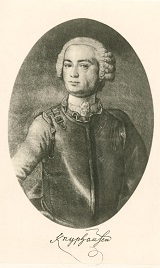The Battle of Brandywine: — Part 3 of 10
Knyphausen vs. Maxwell
All the World vs All the Other World

General Knyphausen
Artist and date unknown
The Miriam and Ira D. Wallach Division of Art, Prints and Photographs: Print Collection, New York Public Library.
The British column continued its advance on Welch's Tavern. They were stopped by an English-born Quaker woman, who approached General Knyphausen and said, "My dear man, do not go down there, for George Washington is on the other side of the stream, and he has all this world with him."
Unruffled, Knyphausen replied, "Never mind, Madam. I have all the other world with me."
Knyphausen was under orders "to amuse the Americans," convincing them that "all the other world" was with him. William Maxwell, his American opponent, had orders to delay the advance.
Maxwell would fire from cover and fall back toward the river. The British advanced slowly amid a cloud of musketfire and at great expense in lives.
A British soldier made the following diary entry:
[The Queen's Rangers and Ferguson's riflemen] fell in very early with large Bodies of the Enemy who form'd upon ev'ry advantageous Post & behind Fences fired on the Troops as they advanc'd — This galling fire was sustain'd the whole way by the Queen's Rangers commanded by Capt. Weyms of the 40th & Rifle Men by Capt. Ferguson of the 70th — who encouraged by the Example of their Leaders behav'd with a degree of perseverance & Bravery which would have done Honor to the best Established Corps.
After a series of heavy skirmishes, in which dense smoke often choked off the morning sunlight, the British forced Maxwell back to the east bank. At about 10:30 the firing died down, save for an occasional artillery exchange across the creek.
The Americans and British now were face-to-face on opposite sides of the Creek. But the British kept busy. Knyphausen was under orders not to reveal his true troop strength, but rather make it appear as if the entire British army were with him. To achieve this sham effect, the Hessian general ordered marches and countermarches up and down and in and out of the hills. He also positioned great numbers of soldiers from his columns in the fields that opened from the Nottingham Road onto the creek. He also left the British baggage train in plain sight.
Knyphausen had successfully made his way to the west bank of the Brandywine and had bought time for Howe and Cornwallis. Maxwell delayed the British advance, thus fulfilling his orders.
British casualties numbered about 300 — a lot for an "amusement," while American casualties were few. But among the American wounded was a young officer from Virginia who would go to become Chief Justice of the United States, John Marshall.



